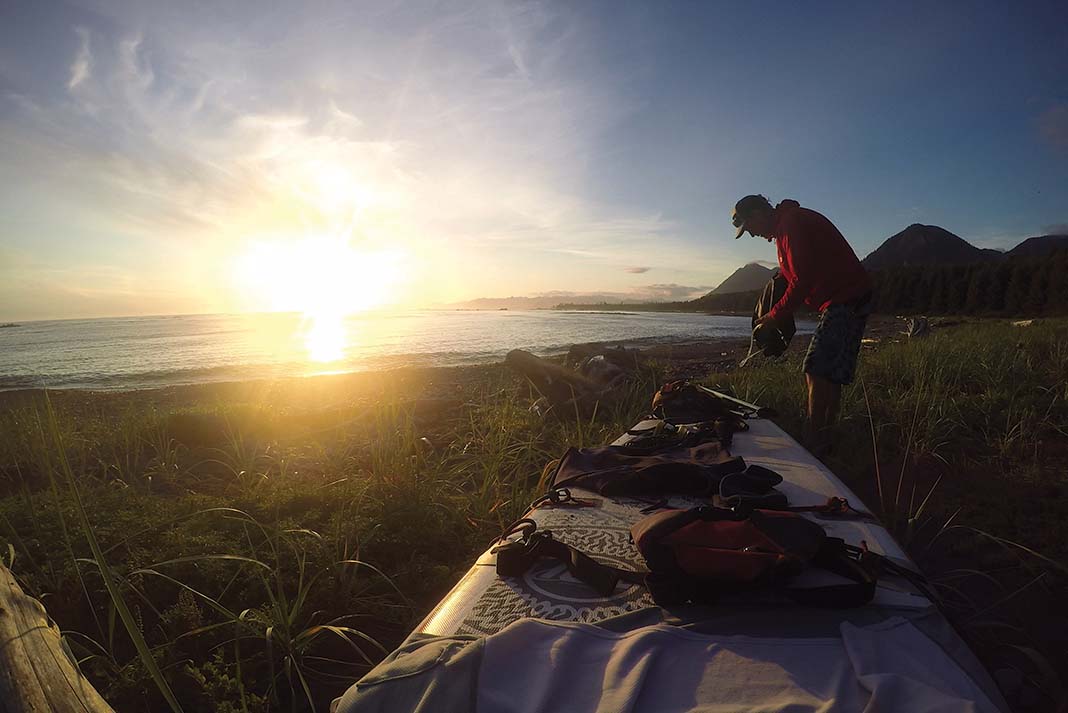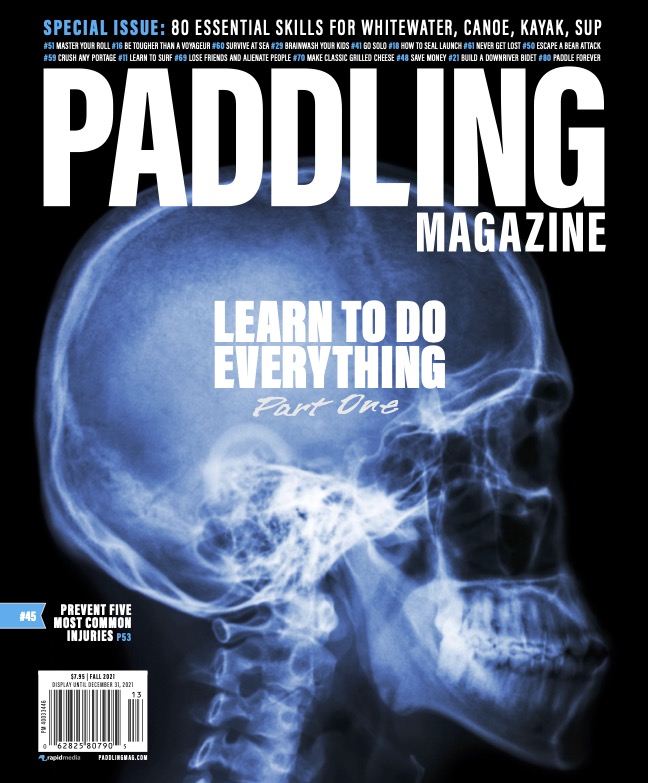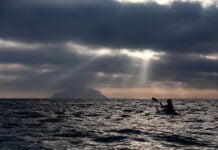Depending on wind and weather, it takes three weeks to paddle from Port Hardy to Tofino, a journey of some 500 kilometers along the exposed outer coast of northern Vancouver Island. To attempt the journey solo demands a full palate of skills and experience—and arguably, some cahones. Five years ago, my first attempt aboard a sit-on-top kayak didn’t go according to plan. But I received a sign. Would my second try at a solo expedition, aboard a SUP this time, go any smoother?
The Village Idiot: Surviving a solo SUP expedition
In retrospect, I was woefully unprepared for my first attempt at the trip. My sea kayaking skills were nothing special at the time, but I figured I could drag myself back onboard the sit-on-top boat and continue in case of capsize.
Still, a deep fear overtook me even before I launched—not fear of drowning or being blown offshore, but the terrifying prospect of simply being alone. Then my boat sank. Within the first hour. The hatches leaked. Port Hardy wasn’t even out of sight.

Knee deep in the ocean in fading twilight, I dragged my swamped boat ashore and tried to salvage what food and gear I could. Then, my hand bumped into something below the surface. It was black, with a touch of red and white. A baseball cap. Covered in barnacles and seaweed, it had washed in from the open Pacific on a flooding tide. A few seconds earlier or later and I would have missed it.
Pulling the hat from the water, I read the words emblazoned across its brim: “Your Village Called. Their Idiot Is Missing.” Clearly, the universe was sending me a message.
Second attempt leaves civilization far behind
When I told friends I was going to try again, this time on a paddleboard, the phrase “village idiot” was uttered more than once. Just launching from Port Hardy was a fiasco. I’d flown in earlier that day, inflating my board on a busy fishing wharf and lashing 20 days of food and gear to the deck. I called home before putting my wallet, phone and city clothes on a bus to Tofino. My voice cracked as I talked to my wife. The distant sound of my cheery young boys brought sobs.
It wasn’t until 6 p.m. that I finally paddled away, my board feeling heavy and unstable in the chop. I’d been bucking a brisk wind for 20 minutes when I realized I’d forgotten to buy apples, bagels and cheese. Turning back, I trudged into town.
An hour later, Port Hardy was once again fading behind me when I realized I didn’t have a lighter or matches. Seriously? I’d been planning this trip for months, but now scared and emotional, I was forgetting the most basic things. I needed to get a grip.
Two hours later, I’d clawed my way 10 kilometers along the coast. As a red sun dropped over the ocean, I dragged my board up a pebble beach and set up camp in a hobbit-like enclave of dark salal and fir.
My alarm woke me at 4 a.m. It was still pitch black. The tent was sodden with dew. Thirty minutes later I set off in fog, feeling my way along the shore. The ocean was glass. Seals followed curiously in my wake, and the cries of oystercatchers and gulls echoed off rocky headlands.
“Pulling it from the water, I read the words emblazoned across the brim: ‘Your Village Called. Their Idiot is Missing.’ Clearly, the universe was sending me a message.”
By mid afternoon, I had covered 60 kilometers and left civilization far behind. That night I camped among grass-tufted dunes littered with the fresh prints of a wolf pack. Finally, I had some traction.
There was no template to follow, or instruction manual to read. I wasn’t aware of anyone attempting the same trip on a SUP, which meant plenty of unknowns swirled through my mind. How would wind and swell affect the board? Would the D-rings I glued to the deck survive being maytagged by a wave? How would I land and launch in surf? With a fully-loaded board and a long fin I couldn’t just drag my board up the beach.
In the end, I developed a simple routine: Wake early. Be on the water by sunrise. Perpetually watch the sky, the winds, the currents, the tides. And paddle; hour after hour. Day after day.
Battling the Brooks
The crux of any trip from Hardy to Tofino is rounding the Brooks, an immense point that juts 20 kilometers into the Pacific, the so-called Everest of the Pacific Northwest. For years I’d imagined the move in my mind and played through every variable. But, a low-pressure system descended as I approached, forcing me to take shelter in a cove.
Hours later, a lobster boat putted in. Two sun-bleached men invited me aboard and offered an omlette. They suggested that if the winds didn’t break, they could carry me around the Brooks the next morning. The forecast was for five days of gales.
“A friend once referred to paddleboarding as the snowshoeing of the ocean. It’s slow and plodding, and some might argue without justification when compared to a seaworthy kayak.”
At home, my wife and boys were waiting. Would I be cheating myself to accept help? Or would I be cheating my family if I waited a week in this cove, just to say I’d paddled every inch of the shoreline? Eventually I looked at the Village Idiot baseball cap I wore and my way seemed clear. Two days later, the Brooks behind me, I set off again.
Paddleboarding: The snowshoeing of the ocean
A friend once referred to paddleboarding as the snowshoeing of the ocean. It’s slow and plodding, and some might argue without justification when compared to a seaworthy kayak. Admittedly, the inability of my board to fight a contrary wind left me feeling constantly exposed. The slightest stirring of the air brought a shadow of doubt. More than once I fought for all I was worth, down on my knees, to reach the safety of land.

Yet, as a kayaker and canoeist for more than two decades it felt good to stand up. I saw more standing, both in the water below and on the ocean ahead. That’s the first SUP metaphor for life: stand up whenever you can.
And the second: stop worrying about falling. As every paddleboarder knows, it is easy to put a fantastic amount of mental and physical energy into staying upright. Yet, whenever we do fall, it’s never as bad as we imagined.
Stand often, fall often. But take my advice for what its worth, coming from the Village Idiot.
Bruce Kirkby finished his 500-kilometer SUP expedition in 20 days. A bestselling author and explorer, see more of his work at brucekirkby.com.
This article first appeared in the 2016 Paddling Buyer’s Guide and also appeared in Paddling Magazine Issue 65. Subscribe to Paddling Magazine’s print and digital editions here, or download the Paddling Magazine app and browse the digital archives here.
You’ll stand often, and fall often, on a SUP expedition. | Feature photo: Bruce Kirkby










I just read your story and was perplexed by your comment about running into a lobster boat as you approached the Brooks Peninsula?? There is no commercial fishing for lobster in BC and lobster aren’t typically found in the Pacific NW. Saying you encountered a lobster boat makes me question your story.